Choose your Brembo Upgrade System
2 Piece Discs
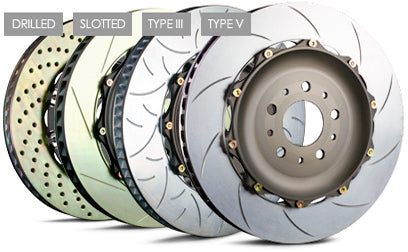
The same discs raced on every weekend in World Challenge, Grand AM, ALMS, NASCAR, World Rally, etc. are utilized in the Gran Turismo (GT, GT-R) and Racing program. Brembo 2-piece discs are made up of an advanced cast-iron alloy which offers an exceptional coefficient of friction and resistance to thermal shock and fatigue. As the braking system’s primary function is to dissipate heat, larger, more sophisticated discs are used in order to increase the fade resistance of the system. These discs are directionally vented for enhanced cooling, as well as drilled or slotted for improved consistency, continuously cleaning and refreshing the pad surface.
Brembo at a glance
200+
The Brembo High Performance (HP) Program is the direct result of winning over 200+ World Championships and decades of designing brake systems for the worlds top supercar manufacturers. Brembo Dominated Motorsports: Formula 1, World Rally Championship (WRC), NASCAR, Champ Car World Series, Indy Racing League (IRL), American Le Mans Series (ALMS), Grand Am Rolex Sports Car Series, Speed World Challenge, and FIA GT Championship.
Brembo has a unique relationship working directly with automotive manufacturers to develop high performance braking solutions specifically for your vehicle. You can rest assured that every system designed by Brembo is specifically tuned for your vehicle like no other braking system on the market. Brembo supplies over 30 automotive manufacturers including Acura, Aston Martin, Audi, BMW, Cadillac, Chrysler, Dodge, Ferrari, Ford, General Motors (GM), Honda, Infiniti, Jaguar, Jeep, Lamborghini, Land Rover, Lexus, Maserati, Mercedes-Benz, Mitsubishi, Nissan, Porsche, and Subaru.
Brembo uses its own foundries in the industrial process, whereby bringing a thorough knowledge of metallurgy to its design know-how which also creates further synergy in the optimization of the production cycle. The research and development phase is flanked by the testing phase which involves static, comfort and road testing and dynamic tests on test benches. Brembo brakes are manufactured under quality and environmental ISO 9004 and ISO 14000 management standards which puts Brembo in a league of its own in high performance braking.
Brembo 2 piece discs at-a-glance
Works with OEM calipers
System Includes
- Upgraded Discs Used with OEM
- Calipers (sold in pairs)
Hardware Type
- “D” Type Bobbin
- “H” Type Bobbin
Disc Construction/Material
- Disc: Proprietary Material
- Bell: Billet 6061 T6 Aluminum
Disc Types
- Slotted
- Drilled
- Type III
- Type V
Disc Finish
- Zinc
- Zinc
- -
- -
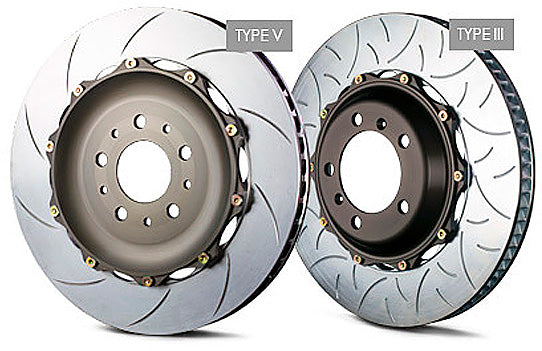
2-Piece Discs
Through Brembo’s comprehensive understanding of materials and advanced design capabilities, Brembo’s 2-piece discs are designed to be as lightweight as possible without compromising strength or longevity. Achieving this level of design is a capability that sets Brembo apart.
By manufacturing the center section out of precision milled billet aluminum, a great deal of weight can be saved in this key location. This reduces both unsprung and rotating weight which benefits handling, acceleration, and overall vehicle dynamics.
Brembo discs are coated with zinc ("gold" color) to provide an attractive corrosive resistant finish.
Superior metallurgy and exceptional engineering allow Brembo discs to exceed in the most demanding conditions. Their advanced cast iron alloy lasts longer than any disc in the high performance and racing market.
Brembo’s proprietary floating hardware system permits a specific amount of radial and axial float which allows the disc to grow independent from the bell, averting thermal distortion when subjected to extreme temperatures. It also preloads the disc assembly to prevent premature wear and eliminate noise during street use.
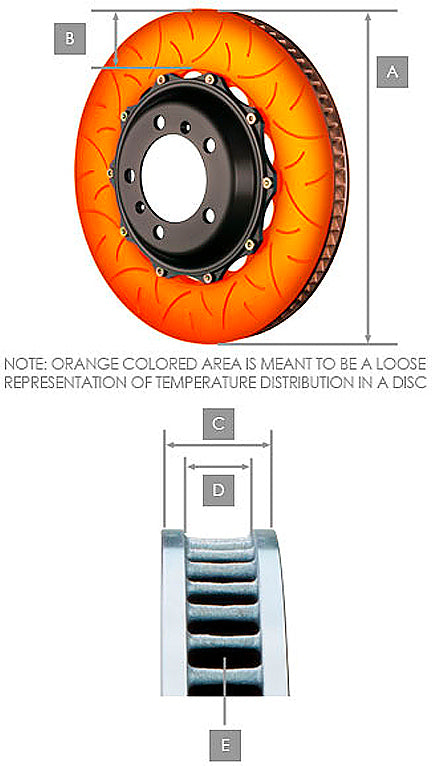
Disc Thermal Capacity
A Mass: The area located in the outer ring of the disc (shown in orange), dictates thermal capacity. This consists of annulus, width, diameter, air gap, and vane design.
B Annulus: The area between two concentric circles. This dimension directly correlates to the friction surface area of the brake pad.
C Disc Width: The overall thickness of the disc. Calipers are designed for a specific width.
D Air Gap: The area located between the rotor plates surface is airgap. The amount of airgap is a crucial factor in channeling airflow.
E Vane Design: Exclusive venting system that improves cooling capacity which increases resistance to brake fade.
Brake systems are designed to operate best within a prescribed temperature range. While modern high performance friction materials broaden this temperature range, it is critical that the brake disc in a system has adequate thermal capacity.
Thermal capacity, or heat storage capacity, is determined by how much weight or mass is located in the outer ring section of the disc. This is the area where the friction surface of the disc meets the internal vanes (orange colored area in the diagram shown). The more mass located in this area, the more thermal capacity a disc has.
CROSS DRILLED
- Cross drilled discs run at slightly lower temperatures due to added air flow through the surface of the disc where heat is generated.
- They are also highly effective in wet conditions and shedding debris from the disc to ensure a clean braking surface.
- Improve pad “bite”, improve wet weather performance, continuously refresh the brake pad.
Slotted Discs
- Slotted discs are recommended when using race pad materials or compounds. the vehicle is submitted to extreme braking duties such as towing or hauling heavy loads.
- Improve pad “bite”, improve wet weather performance, continuously refresh the brake pad.
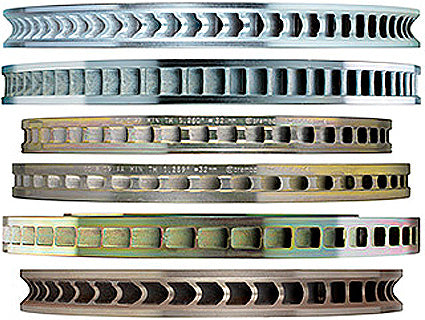
Airflow / Cooling
The curved vane disc is directional, and curved vane disc must be installed with the vanes running back from the inside to the outside diameters in the direction of rotation. Orienting the disc in the manner creates a centrifugal pump. The rotation of the disc causes air to be pumped from the center of the disc, through the vanes, and out through the outside diameter of the disc. This greatly enhances the disc’s ability to dissipate heat. Additionally, all of Brembo’s slotted discs are directional, regardless of the vane geometry. The discs should be installed such that the end of the slot nearest the outer edge of the disc contacts the pad first.
TECH NOTE: It is a popular misconception that the cross drill pattern determines the direction of rotation of the disc. In truth, for an internally vented drilled disc, the geometry of the vanes dictates the direction of rotation.
Disc Hardware
The coupling between the bell, disc and disc hardware has been carefully studied by Brembo to maximize performance, comfort, and longevity. These proprietary disc hardware systems were developed though extensive involvement in professional motorsports and supplying the worlds top OE auto manufacturers.
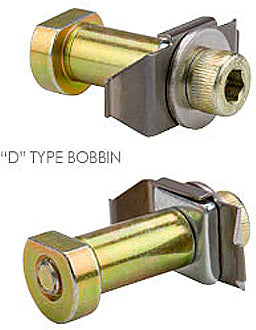
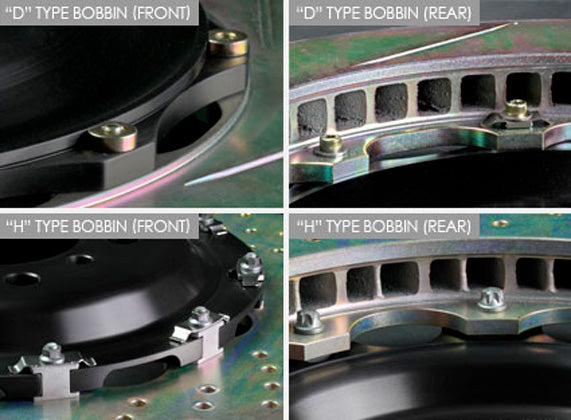
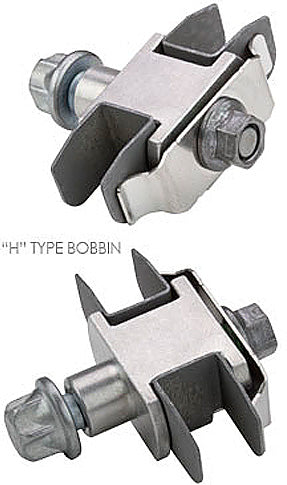
How it works
During braking, torque is transmitted from the disc to the bell through a fastener called a bobbin. This type of mounting system is designed to allow a specific amount of float in both radial and axial directions. This allows the disc to expand and contract under high temperature which reduces stress and increases longevity of the related components.
Brembo’s unique anti-rattle disc hardware utilizes a spring fastener in order to slightly preload the assembly which eliminates the noise generally associated with floating discs.
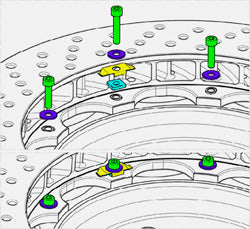
The floating 2-piece anti-rattle disc hardware system, commonly used in high performance braking systems, was actually developed by Brembo back in the mid 90’s. This innovation was initially engineered exclusively for the McLaren F1 supercar which is why the hardware is often nicknamed the “McLaren” spring.
Back to top


